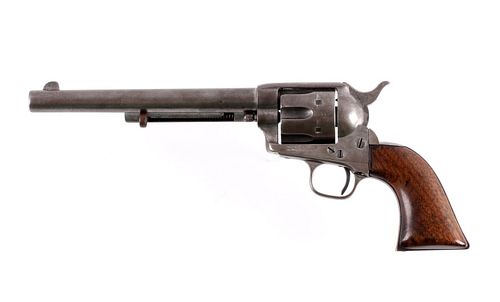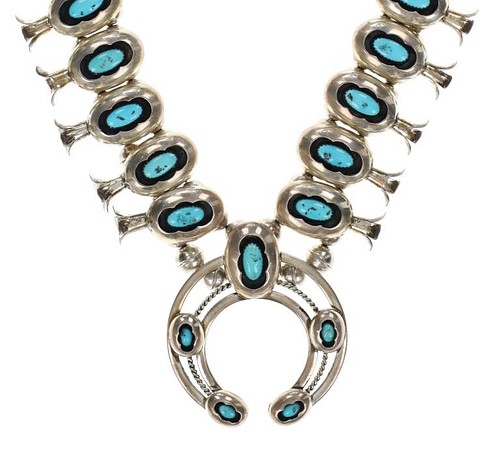Moses “California Joe” Milner Colt SAA Revolver
Two ways to bid:
- Leave a max absentee bid and the platform will bid on your behalf up to your maximum bid during the live auction.
- Bid live during the auction and your bids will be submitted real-time to the auctioneer.
Bid Increments
| Price | Bid Increment |
|---|---|
| $0 | $5 |
| $50 | $10 |
| $100 | $25 |
| $500 | $50 |
| $1,000 | $100 |
| $2,000 | $250 |
| $5,000 | $500 |
| $10,000 | $1,000 |
| $25,000 | $2,500 |
| $100,000 | $5,000 |
About Auction
Jan 27, 2024
Join us this New Year for our Echoes of the West January 27th sale. The auction includes over 750 rarities, such as Little Bighorn attributed firearms, tremendous beadwork, outstanding rare Navajo rugs, a beautiful vintage estate Navajo jewelry collection, and so much more. North American Auction Company tucker@naabid.com
- Lot Description
This is an excellent Colt Single Action Army 7th Cavalry Revolver issued to civilian scout, Mosses “California Joe” Milner by General George Armstrong Custer at Fort Lincoln and also owned by Dr. McGillycuddy and Indian Police member Afraid of Eagle. It is known that Custer issued nickel plated Colt SAA revolvers to his Indian Scout’s as shown by the photograph taken by William H. Illingworth and developed by Buckbee-Mears Co. Lindeke Bldg., St. Paul, Minnesota, Coded 77837. This photograph shows Moses Milner “California Joe” with General George Armstrong Custer, along with Little Sioux, Bloody Knife, and Goose (Custer Scouts) with each Indian holding the Colt Single Action Army revolver with nickel plating that Custer issued them from the shipment on July 29, 1874 by H&D Folson to Fort Lincoln. These pistols were delivered by Charles Reynolds, a scout and guide for Custer charged with carrying the mail back and forth between the expedition sites and Fort Lincoln. On one of Reynolds return trips, he brought back three of the nickel-plated revolvers which Custer promised to his favorite Indian Scouts. To document the occasion, the above photograph was taken. Also in the photograph was Custer’s Scotch Staghounds Tuck and Bleuch (the dogs) in front of the Black Hills Expedition N.P.Rwy.Co wall tent. It was thought that the man in uniform was Private John W. Burkman, but this was incorrect as this was clearly Moses Milner. Moses Milner was a 7th Cavalry Civilian Scout and was known to wear his Civil War Cavalry uniforms (a private serving for Custer would have been ordered to wear the current uniform). Moses “California Joe’s” revolver did not arrive in the same shipment and thus was not presented to him for this photograph. California Joe’s revolver with serial number 10960 was included in a shipment from Schuyler, Harley and Graham, along with seven other revolvers: 11258, 11722, 11843, 12364, and 13221. Wendell Grangaard, Battle of the Little Bighorn Historian and Togia Language carvings expert, personally reviewed the duplicate records from the Fort’s Archives from two of the Ordnance Captains, not being allowed to make copies he wrote down all of the information of which serial numbers were shipped. This revolver was part of the July 29th 1874 shipment by Schuyler, Hartley, and Graham and showed a factory original blue finish with no US markings, which would align with the order’s from Custer for Civilian Scouts accompanying the 7th Cavalry at the Black Hills Expedition to have blue finish revolvers. This has been documented in the book, “Documenting the Weapons Used at the Little Bighorn” by Wendell Grangaard 2015 pages 148 and 151. Moses “California Joe” Milner started as a scout for Custer in 1868. He was a scout for Custer’s Washita Campaign, including leading the 7th Cavalry back to Washita to discover Major Joel H. Elliot and the nineteen soldiers killed at the Washita Battle. Mosses Milner was appointed Chief if George Custer’s Scouts at one point. Milner was also responsible for leading Custer in the famous Black Hills Expedition, in which this revolver would have been used, where he won a piece of land to build a farm near the area on which Rapid City stands today. California Joe was not with Custer at the Little Big Horn but Milner said he should have been with him because he would have talked Custer out of attacking such a large force. In 1866 Milner met James B. Hickok “Wild Bill” in Newton, Kansas and soon after the two became good friends. Wild Bill Hickok offered Milner a job with him and Colorado Charley in the freighting business, but he declined due to his love of danger and scouting. At the end of the Washita Campaign, Milner met up with Wild Bill Hickok in Kansas when he traveled with Custer to Fort Hayes on the Kansas Pacific Railroad. After some time in California, Milner wrote to Custer to see if he could join him as a scout. After Wild Bill Hickok was murdered on August 2nd 1876 by Jack McCall at the Sixy-Six Saloon in Deadwood, South Dakota, California Joe reached Deadwood and met with Colorado Charley. Charley had taken possessions of Wild Bill’s things, which included two Colt 45 Six Shooters, a needle gun and the derringer with which he had killed Dave Tutts in 1865. Charles “Colorado Charley” Utter handed Milner one of Wild Bill’s revolvers and said, “If you can kill him, do it with one of Bill’s own guns.” Milner accepted the gun and at the same time handed Utter one of his own firearms in exchange (believed to be a Colt 44). California Joe went after Jack McCall, but found him to had already been incarcerated at the Laramie, Wyoming jail. Joe informed the jailer that he would save the expense of a trial if he could just see the prisoner for half a minute, but he was not allowed in the jail due to his temper. Jack McCall was later hung in 1877 after being found guilty of murder in the first degree. Government Records shows that Californai Joe Milner joined Crook’s command as a scout from October 3, 1876 to October 25, 1876 and Milner was paid for his services at Fort Robinson, Nebraska. Milner was then ordered to join Colonel Mackenzie and the 4th Cavalry in a campaign against the Cheyenne led by Little-Wolf and Dull-Knife. Before Riding to Red Cloud Agency in true Frontiersman fashion, Milner and his band of men spent a few days of recreation at the nearest saloon. On October 29th 1876 Milner was in an altercation with Tom Newcomb at Fort Robinson, Nebraska. Trying to defuse the situation, Joe suggested they put down their pistols and have a drink. Newcomb left, while Joe thinking the matter had been resolved, was speaking to some friends. Newcomb returned with a Winchester Rifle and shot Moses “California Joe” in the back and killing him. He was 47 years old. Dr. McGillycuddy’s letter to Joe Milner on April 8m 1927 tells of the story. After his death Dr. McGillycuddy retained all of Joe’s possessions. Later Dr. McGillycuddy gave the Colt Model 1873 45 cal. Revolver owned by California Joe to Afraid of Eagle, one of the Indian police. Afraid of Eagle marked the grips of the revolver in Togia language carvings for “Lemita” (my possession) and said he rode with Bull Bonnet. After Afraid of Eagle finished his work as an Indian Scout, he had the Sans Arc pistol maker cut the barrel off and remove the ejector housing. The family eventually sold the revolver from an antique store in Iowa in 1952 to Robert Roseman’s father. His father then had the original barrel replaced with a 7.5” example and additional ejector housing replaced, the current form the revolver is in today. Included in the documentation is the correspondence from Robert Roseman stating that he had the earlier factory letter (which we have included a copy of) along with the original factory serial number matching barrel with the original alterations (which he kept). The pistol has been examined and authenticated by Togia language expert, Wendell Grangaard of The Guns of History, Inc. The revolver was found to show hand carved symbols in the Togia Language. Left side marked, “PAT. SEPT. 19, 1871 / PAT. JULY, 2, 1872”, “45 CAL”. Top marked, “COLT’S PT. F. A. MFG. Co. HARTFORD CT. U.S.A.” Also marked with the serial number 10960 on the trigger guard, receiver frame, and butt along with 0960 on the cylinder wall with “A”. The piece comes with the signed letter describing the piece’s history from Wendell Grangaard along with a detailed illustration showing the markings he has translated. Wendell Grangaard is the foremost knowledge on the Togia language along with the Battle of the Little Bighorn as he is the author of the book, “Documenting the Weapons Used at Little Bighorn” 2015. Wendell was also intricate in the authentication and examination of the historic George Armstrong Custer Captured Sharps Carbine from Chief Black Kettle that sold at auction for $127,000. Comes with documentation including a detailed description authenticating the piece signed by Wendell, along with a illustration showing the togia language carvings drawn. This is truly a wonderfully documented authentic original Colt 1873 owned and used by Moses “California Joe” Milner, considered one of the most famous Civilian Cavalry Scouts and personal friend to Wild Bill Hickok. From the outstanding Historic Fort Pierre, South Dakota firearms and Indian Artifact Collection of Steve Livermore. Included in the lot is the book, “California Joe: Noted Scout and Indian Fighter” by Joe E. Milner and Earle R. Forrest 1935 (1987 reprint). The historic facts are documented in this items printed provenance which includes information from the above stated book along with, Keith Cochran Colt Peacemaker Encyclopedia Volume 2, and the Welch Dakota Papers.
- Shipping Info
-
North American Auction Company is proud to announce the opening of our new in-house, full-service shipping department. We have listened to you the customer and will now be handling all outgoing packages in our new shipping department. We are confident this new offering will allow for a smooth transition from auction block to your front step. We have partnered with preferred carriers to ensure a safe, efficient delivery that works best with your schedule. Please allow 14-21 days after complete invoice payment is made to package and ship your purchase. After you are notified of your winning bids from our company and your item invoice is paid in full our new shipping department will contact you. Make sure when signing up with our company that your preferred shipping information is up to date as this information will be used to estimate shipping cost. Once the items have been packaged our team will contact you for shipping payment. Shipping invoices and payment will be completely separately than the items invoice. Please notify the shipping department with any alternate request or instructions at mark@naabid.com or 800-686-4216 ext. 3. For a shipping quote please contact the same information above. PLEASE NOTE a shipping quote price can fluctuate in price. Auction company is not responsible for actual shipping cost being higher than quoted shipping cost. Thank you for trusting North American Auction Co. with your bids and shipping. As our shipping department is brand new please understand that delays can be expected.
-
- Buyer's Premium



 EUR
EUR CAD
CAD AUD
AUD GBP
GBP MXN
MXN HKD
HKD CNY
CNY MYR
MYR SEK
SEK SGD
SGD CHF
CHF THB
THB































